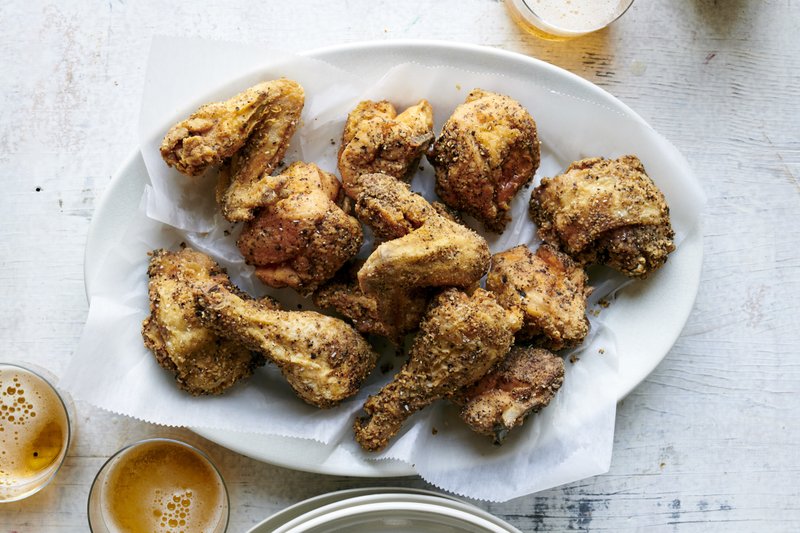If you see a steeple in southeastern Indiana, you can be pretty sure that fried chicken is nearby. If you see the steeple in West Harrison, about 20 miles from the Indiana-Ohio-Kentucky borders, that chicken is fried across the street at St. Leon Tavern by the owner, Aaron Klenke. Most people would call the place a bar, but I call it a place that serves some of the best fried chicken I've tasted.
Until my wife, the novelist Ann Hood, brought me to Greensburg, her father's hometown, telling me I was about to have the best fried chicken of my life, I was certain that I made the best chicken I'd had in my life. To my delight, she was right.
The secret to this fried chicken? Table salt, coarse pepper and flour. Those who want to gild the lily cook it in lard in a skillet.
To learn the craft of southeastern Indiana chicken, I went to the person who I believe makes the best of the best: Chris Harvey, at Wagner's.
Harvey walked me through his process: He put two chickens in a hotel pan, gave the pieces a heavy dose of salt, a serious shake of pepper ("more of both than you would think," he said) and massaged the seasoning in until he could see that the pepper was evenly distributed. He coated them in plain flour in a second hotel pan, then put them into the fat.
While almost every other local restaurant deep-fries the chicken in soybean or vegetable oil, he uses lard. He said it was important to find lard without BHT, an antioxidant that prevents rancidity but leaves a bad aftertaste.
When the fat in a chicken-filled skillet got low, he dipped a pan into melted lard kept in a stockpot beside the stove and filled the skillet up nearly to the brim and kept on frying. When one pan of chicken was done, he removed the pieces, then emptied the pan — the fat, the "crumbs" at the bottom, and all — back into the stockpot of lard. The crumbs sank to the bottom, and would be used to flavor the roux base for making the gravy.
He then scraped the pan clean and toweled it out until it was shiny and black, before refilling it with the used, golden-brown fat to fry the next batch.
What Harvey cooks the chicken in, then, is a peppery, chicken-flavored lard -- my guess as to why the flavor of this chicken is so rich.
The finishing touch: Just before he removes the chicken, he adds about two tablespoons of water, which makes the oil bubble up. It "seals in the flavor," he said, admitting that he didn't know if that was true. "They used to use beer."
I don't know if this adds anything, either, but I do it because it's a tradition and a festive conclusion to frying chicken, like flaming a crêpe suzette. The result, after 20 minutes in the fat, is a crisp, peppery, moist chicken of exquisite simplicity.
Indiana Fried Chicken
1 (4-pound) chicken
1 tablespoon fine table salt, plus more to taste
2 ½ to 3 tablespoons coarsely ground black pepper
3 to 4 cups lard or canola oil
3 cups flour, for dredging
4 tablespoons water, at room temperature
Remove the legs from the chicken at the joint. Separate the drumsticks from the thighs at the joint by placing the leg skin side down and following the line of fat that runs directly above the joint. Remove the wings at the joint. Place the chicken neck side down and separate the back from the breast using a knife or kitchen shears. Cut the breast into quarters. Cut the back in half crosswise.
Transfer the chicken pieces to a large bowl. Sprinkle evenly with the salt and pepper and toss to coat, rubbing the chicken pieces to make sure the seasoning is uniformly distributed.
Add the lard or oil to a large, deep cast-iron skillet or Dutch oven. You should have about 1 inch of fat, enough that the chicken will be submerged about three-quarters of the way up. Heat over high until the oil reaches 350 degrees, reducing the temperature as needed to medium or medium-high to keep it around 350 degrees.
Add the flour to a large bowl and dredge the chicken in the flour until thoroughly coated. Working in 2 batches, carefully lay half the chicken into the hot fat and pan-fry, turning the pieces frequently for even cooking, until the chicken is golden brown and the thighs are cooked through, 10 to 15 minutes per batch.
Just before removing the chicken, turn off the heat. Carefully add 2 tablespoons of water to the fat. (It will boil up immediately. Add the water directly to the fat at a close range in the center of the skillet to minimize splatter; feel free to use a ladle if you don't want to get too close.) When the water has cooked off and the vigorous bubbling has subsided, transfer the chicken to a paper-towel-lined plate. Turn the heat back on, bringing the oil back to 350 degrees, and fry the remaining batch of chicken, turning off the heat before adding the final 2 tablespoons of water. Transfer chicken to another paper towel-lined plate and serve immediately.
Makes 2 to 4 servings.
Food on 06/26/2019

